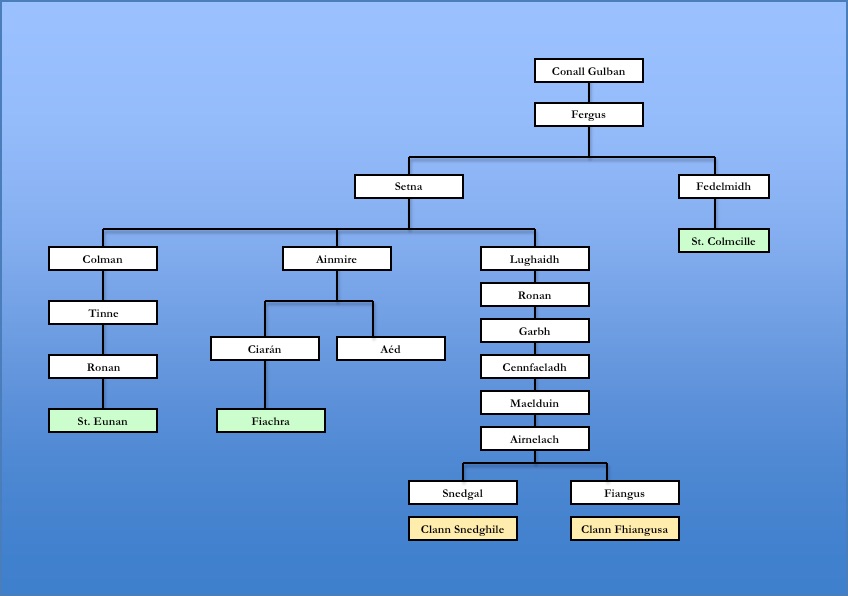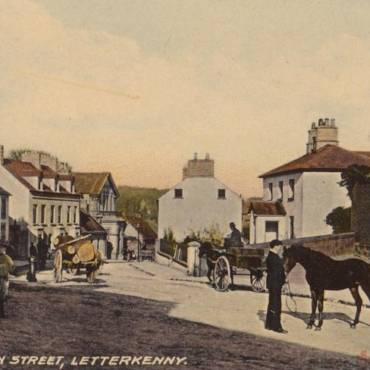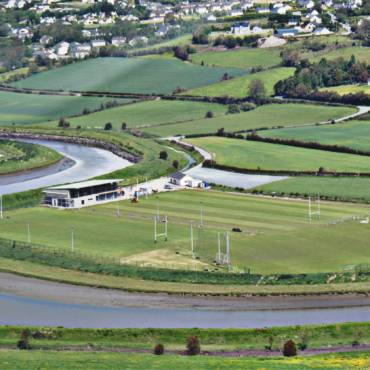Ancient Tribes and Conwal Settlement
Several large tribes governed the large territories of Tír Chonaill, (roughly the area of what we know as Donegal today without Inishowen) and the balliboe of Leitir Ceanainn was within one of these territories. The boundaries of the territory of the Cinéal Luighdheach tribe, (the ‘kindred of Lughaidh’), were described in the Book of Fenagh:
“From the same impetuous Dobhar,
The Tricha of Lughaidh, son of Setna,
Extends to the river of clear aspect,
The name of which is Suilidhi”
This sizeable area was known as Tír Luighdeach and as the small balliboe of Leitir Ceanainn was situated between the rivers of ‘Dobhar’ and ‘Suilidhi’ (Swilly), we can see that it was part of this overall territory of the Cinéal Luighdheach, and two smaller clans within this tribe, the Clann Snedghile and Clann Fhiangusa, are recorded as having had forts at Conwal and Tullygay. The Book of Fenagh informs us that both of these clans were named after two brothers, Fiangus and Snedgal, the sons of Airnelach and were descended from Lughaidh, from whom the tribe got its name. The forts in existence near Conwal today belonged to these clans and not as some would contend, the Ua Canannáin clan.
As the River Swilly was once a territorial boundary marker, other tribes appear to have had settlements on the southern banks. Evidence of the Cinéal nEoghain (the ‘kindred of Eoghain’) and Cinéal nÉanna (the ‘kindred of Enda’) tribes can be found in various place names south of the river. For example, Mongain was the son of Eoghain, and his fort on the hilltop to the south of the river was named after him – Líos Mongain (Lismonaghan) while Corenna comes from Corr Éanna, the ‘Rock of Enda’.
There is a local legend that the town of Letterkenny had its origins at nearby Conwal and after a cat accidently knocked over a lantern, which set fire to the wooden and wattle huts utterly decimating their small hamlet, the people moved east along the river and settled in the area south of the modern day town. According to this legend, these Gaelic locals were the first to create a town in the area and the Scottish planters who arrived in the seventeenth century merely took it over and built their settlement on the opposite side of the River Swilly. Thus, the Gaelic Irish town on the south of the river became ‘Old-Town’ and the planters had their ‘New-Town’ on the opposite hillside. However, we know this legend to be merely that, a legend, and it has no basis in historical fact. Most likely it was a ‘Coote’ and not a ‘cat’ that destroyed the settlement at Conwal when Sir Charles Coote destroyed the settlement following his victory at the Battle of Scarrifhollis in 1650.
The name Conwal comes from the Gaelic ‘Congbhaile’ meaning an ‘ecclesiastical habitation’ and today we can still see the 12th Century ruins of a church that was built on the site of an original abbey. Reading the sign beside this church, we are told that this is the site of an early ecclesiastical settlement dating from the 7th Century when “St. Fiachrius was Abbot”. Thus, it is generally accepted amongst many people that St. Fiachra, the Patron Saint of Gardeners, is the founder of Conwal Abbey. However, under closer inspection, St. Fiachra actually appears to have no connection to the area at all. It was most likely Fiachra, son of Ciarán who was the true founder of the abbey, later becoming confused with a saint of the same name.
The first recording of a place called Conwal comes from the Annals of the Four Masters in the year 913 in which a ‘herenach’ (airchinneach) has died. A herenach was the hereditary keeper of the monastery who had to hold a genealogical connection to the founder:
“913: Scannlan, airchinneach of Congbhail-Glinne-Suilighe, died”.
The next mention we have is from the year 1204, informing us again of the death of a herenach.
“1204: Sitric O’Sruithen, Erenagh of Conwal, i.e. head of the Hy-Murtele, and chief man of all the Clann-Snedhgile for his worth, died, after exemplary penance, and was interred in the church which he had himself founded.”
Fiachra, son of Ciarán, was the nephew of the ruling chief of Tír Chonaill, Aed MicAinmire and he is recorded in the Annals of Tigernach as being the ‘other’ founder of the monastery at Derry and dying in the year 619. If then, he founded a monastery in Derry, could he have also founded one prior to this in Conwal? To consider this, we would need to connect him to the herenachs (keepers) of the abbey, as they had to be related in some way to the founder. The herenach at Conwal in 1204, Sitric O’Sruithen, was “chief man of all the Clann-Snedhgile”. As we have seen, this Clan Snedhgile of Congbhaile were descended from Lughaidh, who was Fiachra’s granduncle and given that the keepers of an abbey had to be related to the founder, the significance of this connection becomes clearer. Fiachra, son of Ciarán also holds significant genealogical links both to Colmcille and Eunan thus making it even more probable that he is the founder.
In any research done on the life of St. Fiachra however, no mention is ever made of the Patron Saint of Gardeners spending any time in Donegal. He lived in Kilkenny and later emigrated to France, making a trip north to found a monastery in this local area very unlikely. What is most likely to have happened is that through the passing down of history through the centuries, Fiachra, son of Ciarán became lost in time and became easily misinterpreted as ‘SaintFiachra’.



